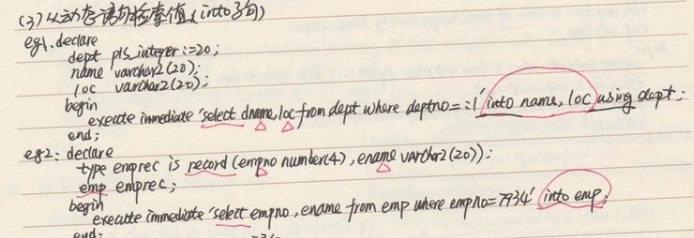Oracle(00):动态sql
一、概述
在一般的sql操作中,sql语句基本上都是固定的,如:
SELECT t.empno,t.ename FROM scott.emp t WHERE t.deptno = 20;
但有的时候,从应用的需要或程序的编写出发,都可能需要用到动态SQl,如:
当 from 后的表 不确定时,或者where 后的条件不确定时,都需要用到动态SQL。
使用execute immediate语句可以处理包括ddl(create、alter和drop)、DCL(grant、revoke)、DML(insert、update、delete)以及单行select语句。
execute immediate语句:
execute immediate dynamic_string [into {define_variable[,define_variable]…|record}] [using [in|out|in out] bind_argument[,[in|out|in out]bind_argument]…] [{returning|return} into bind_argument[, bind_argument]…]
- define_variable用于指定存放单行查询结果的变量;
- using in bind_argument用于指定存放传递给动态sql值的变量,即在dynamic中存在占位符时使用;
- using out bind_argument用于指定存放动态sql返回值的变量。
二、执行ddl、dcl语句
不能使用into和using子句。
begin execute immediate 'create table ma_org(org_codevarchar2(20),org_name varchar2(254))'; execute immediate 'drop table ma_org'; end;
语句
begin execute immediate 'grant insert on ma_org to scott' end;
三、处理dml语句
1、给动态语句传值(USING 子句)
如果dml语句包含占位符,那么在execute immediate语句之后必须要带有using子句;
declare orgcode varchar2(10); orgname varchar2(254); begin orgcode := 1200; execute immediate 'select org_name fromma_org where org_code = :X' into orgname using orgcode; dbms_output.put_line(orgname); end;
2、从动态语句检索值(INTO子句)
3、动态调用存储过程
declare l_routin varchar2(100) := 'gen2161.get_rowcnt'; l_tblnam varchar2(20) := 'emp'; l_cnt number; l_status varchar2(200); begin execute immediate 'begin ' || l_routin || '(:2, :3, :4); end;' using in l_tblnam, out l_cnt, in out l_status; if l_status != 'OK' then dbms_output.put_line('error'); end if; end;
4、处理包含returing子句的DML语句
如果dml语句带有returning子句,那么在execute immediate语句之后必须带有returning into子句,并且此时只能处理作用的单行上的dml语句,如果dml语句作用在多行上,则必须使用bulk子句。
declare orgcode varchar2(10); orgname varchar2(254); rname varchar2(254); begin orgcode := '1200'; orgname := '天津市分行'; execute immediate 'update ma_org set org_name=:X where org_code = :Y returning org_name into :rname' using orgname, orgcode returning into rname; dbms_output.put_line(orgname); end;
5、在retuing into中使用bulk collect into
四、处理多行查询
oracle通过使用bulk collect into子句处理动态sql中的多行查询可以加快处理速度,从而提高应用程序的性能。当使用bulk子句时,集合类型可以是plsql所支持的索引表、嵌套表和varray,但集合元素必须使用sql数据类型。在oracle9i以后,有三种语句支持bulk子句,execute immediate,fetch和forall。
1、使用动态游标(游标变量)处理多行查询类动态sql语句。
DECLARE TYPE ref_cur IS REF CURSOR; rc ref_cur; emprow emp%ROWTYPE; v_sql VARCHAR2(100):= 'select * from emp where deptno = :x'; --动态执行的SQL语句 BEGIN OPEN rc FOR v_sql USING 30; --打开游标,绑定执行的SQL语句,并传递参数 LOOP FETCH rc INTO emprow; EXIT WHEN rc%NOTFOUND; dbms_output.put_line('name:'||emprow.ename||' sal:'||emprow.sal); END LOOP; CLOSE rc; END;
2、在execute immediate中使用bulk collect into
示例:
declare type org_table_type is table of ma_org%rowtype; org_table org_table_type; v_orgcode varchar2(20); begin v_orgcode := '%00%'; execute immediate 'select * from ma_org where org_code like:v_orgcode' bulk collect into org_table using v_orgcode; for i in 1..org_table.count loop dbms_output.put_line(org_table(i).org_code||','||org_table(i).org_name); end loop; end;
3、在forall语句中使用bulk collect into语句
示例:
declare type type_org_code is table of ma_org.org_code%type; type type_org_name is table of ma_org.org_name%type; v_orgcode type_org_code; v_orgname type_org_name; begin v_orgcode := type_org_code('1100','1200'); forall i in 1..v_orgcode.count execute immediate 'update ma_org set org_name = org_code||org_namewhere org_code = :p1 returning org_name into :p2' using v_orgcode(i) returning bulk collect into v_orgname; for i in v_orgname.first..v_orgname.last loop dbms_output.put_line(v_orgname(i)); end loop; end;
posted on 2011-12-09 17:24 springsnow 阅读(489) 评论(0) 收藏 举报




 浙公网安备 33010602011771号
浙公网安备 33010602011771号